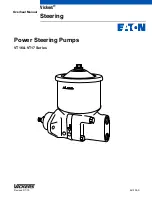
7
2.1 Listings and classifications
2.2 Dimensions
See dimensions at the end of these instructions.
All dimensions are in inches.
3. Installation
3.1 Safety instructions
• When working with chemicals, local safety rules
and regulations must be observed (e.g. wear
protective clothes).
• Before starting work on the dosing pump and sys-
tem, disconnect the electricity supply to the pump,
ensuring that it cannot be accidentally switched
on. Before reconnecting the electricity supply,
make sure that the dosing hose is positioned in
such a way that any chemical left in the dosing
head is not ejected, thereby exposing persons to
danger.
• If the vent valve in the dosing head is used, it
must be connected to a hose which is led back to
the tank.
• When changing a chemical, make sure that the
materials of the dosing pump and system are
resistant to the new chemical. If there is any risk
of chemical reaction between the two types of
chemicals, clean the pump and system thoroughly
before adding the new chemical.
Proceed as follows:
Place the suction tube in water and press the
button until residual chemical has been removed.
NOTE:
When the buttons
and
are pressed
simultaneously, the pump can be set to run for a
specific number of seconds at maximum capacity.
The remaining number of seconds will appear in
the display. The maximum value is 300 seconds.
• The liquid is under pressure and may be hazard-
ous.
3.2 Installation environment
• Exposure to direct sunlight should be avoided.
This applies especially to pumps with plastic dos-
ing heads, as this material can be damaged by
sunlight.
• If the pump is installed outside, an enclosure or
similar protection is required to protect the pump
against rain and similar weathers.
3.3 Installation of pump
• See also the installation example in section
.
•
CAUTION:
The dosing head may contain water
from the factory test. If a liquid which must not
come into contact with water is to be dosed, it is
recommended to let the pump run with another
liquid to remove the water from the dosing head
before installation.
•
NOTE:
Tighten the bolts in the dosing head after
2 to 5 operating hours (torque 5 Nm).
• Always install the pump on the supporting foot
with vertical suction and discharge ports.
• Always use suitable tools for the mounting of
plastic parts. Never apply unnecessary force.
• Make sure that the dosing pump and system are
designed in such a way that neither system equip-
UL Listed to U.S. and Canadian
safety standards.
ANSI/NSF61
Certification is based upon a
dose rate that yields a sodium
hydroxide (NaOH) concentra-
tion in potable water that does
not exceed 100 mg/l.
Certification is based upon a
dose rate that yields a sodium
hypochlorite (NaOCl) concen-
tration in potable water that
does not exceed 80 mg/l.
Certification of this product has
been performed to the health
effects requirements of NSF/
ANSI Standard 61, which as-
sesses the acceptability of
potential extractants from the
chemical pump. No evaluation
has been performed on the
strength or efficacy of the
chemicals fed. The specified
chemicals are not certified by
UL to NSF/ANSI Standard 60,
so the operation, maintenance
and the consistency of the
source ingredients may affect
the performance of the dosing
pump.
NOTE
: For the products in this
document the ANSI/NSF61 cer-
tification applies
• only to pumps produced in
France
• only to pumps with the fol-
lowing material combina-
tions:
- PP/E/C
- PP/V/C
- PV/E/C
- PV/V/C.
• only to pumps with standard
valve (code 1).
See
for further in-
formation.
NOTE
: The pumps are not in-
tended for dosing of drinking
water.
(Power-operated
pump for chemicals)
1Z28
ANSI/NSF61
Dosing pump
65GM
Max. 23°C
NaOH or NaOCl
WARNING!
100%
100%
Grundfos.bk Page 7 Wednesday, May 21, 2008 11:21 AM








































